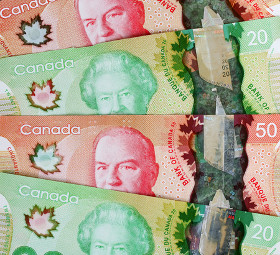
The Canadian dollar fell against almost all most-traded currencies today, even the soft yen. The Swiss franc was the only exception, falling against all other major rivals. The Canadian currency spiked after the release of a GDP report but lost gains almost immediately.
Statistics Canada reported that gross domestic product rose 0.1% in September, the same as in the previous month and matching expectations. Gains were registered in 13 of 20 industrial sectors, with wholesale trade and construction being the biggest contributors to growth. Meanwhile, activity in rail transportation declined. GDP rose 0.3% in the third quarter of this year, slowing from the second quarter’s 0.9% rate of growth. The annualized growth rate was at 1.3% in Q3 versus 3.7% in Q2. The sharp slowdown of the economic growth was a likely reason for today’s fall of the Canadian dollar.
Released separately, Industrial Product Price Index inched up 0.1% in October after falling at the same rate in the previous month. Analysts had predicted no growth for the index. The Raw Materials Price Index dropped 1.9%, matching forecasts exactly, after showing no change in September.
While the GDP report was one of the possible reasons for the loonie’s decline, the drop of crude oil prices was another one. The North American grade of crude dropped about 2.75% in New York to $56.52 per barrel today. The Canadian economy relies heavily on oil exports to generate profit, therefore performance of the commodity usually has a strong impact on the Canadian currency.
USD/CAD climbed from 1.3280 to 1.3302 as of 15:13 GMT today. CAD/JPY dropped from 82.43 to 82.32. CAD/CHF rose from 0.7513 to 0.7522.
If you have any questions, comments, or opinions regarding the Canadian Dollar, feel free to post them using the commentary form below.